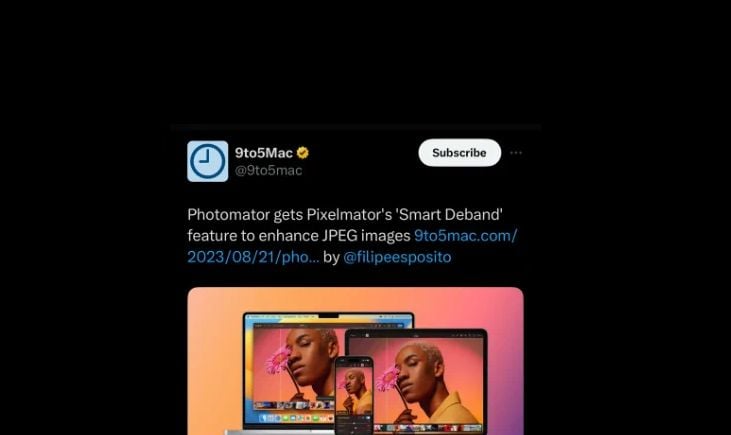SOCIAL
X is Changing How Link Previews are Presented In-Stream, Which Could Impact Your Posting Strategy

I can understand Elon Musk’s push in most cases, in trying to drive certain actions on X, like reducing the reach of tweets from non-X Blue subscribers in order to boost Blue take-up, or limiting the reach of posts with external links to better incentivize direct posting to the app.
I get it, it’s pretty overt logic. But I do think that he often overlooks the potential negatives of such changes in the broader scheme, and how they might change the way that people, including influential users, engage in the app.
The latest example on this front is that X will soon start displaying link previews in a totally different way, with the headline and preview text removed, and just the header image remaining.
As you can see in this example, shared by 9to5 Mac, the new Twitter link preview will maintain the original link display in the tweet, with the header image, and a URL overlaid on the image.
Here’s how the old (right) and new formats look side-by-side:

Essentially, the lower text panel is being removed, while there’ll no longer be an automated header or preview text snippet. You’ll get an image preview, and that’s it, which will put more onus on users to create X-specific posts, as opposed to relying on the article link to convey relevant info.
X owner Elon Musk has confirmed the change, which he has claimed full responsibility for.
This is coming from me directly. Will greatly improve the esthetics.
— Elon Musk (@elonmusk) August 22, 2023
The view is that this will better compress the timeline, and improve overall presentation, with Elon specifically looking to reduce the amount of space that link tweets occupy in-stream.
X is also reportedly informing selected partners that the new design will help in combating clickbait. I mean, people will still be able to write the same text manually, so it’s not entirely clear how this will help in negating bait clicks, but this, apparently, is another reason.
It’s also, reportedly, been pretty unpopular among brands in early feedback, but X is seemingly moving ahead anyway, which could have a significant impact on your X posting process.
Basically, if you’re putting any reliance on preview cards, you’ll need to change your approach, in order to ensure the best presentation for your shared links. It could also impact your older posts, with the same format likely to be applied to all active content. So all your link posts will probably revert to a single image, which could erase a lot of context from your original tweet/post.
But there’s not much you can do about it, other than planning for how you maximize such moving forward, with the change set to come into effect any time soon.
And in line with Elon’s other changes designed to reshape user behavior, the new format could also be a means for X to push more journalists towards posting on X itself, which could also explain this recent tweet.
If you’re a journalist who wants more freedom to write and a higher income, then publish directly on this platform!
— Elon Musk (@elonmusk) August 21, 2023
With long-form tweets now available in the app, along with subscriptions, and its ad revenue share scheme, X is trying to get more original content shared direct to the app, and it’s been keen to highlight the big payouts that some users have been getting in the early days of the new ad revenue scheme.
Maybe, if X can convince more users that native posting is a better option, that’ll help to make X a more relevant, and important news platform, and draw more users to the app for original analysis and insight. Though it’s hard to see many journalists being overly keen to take up Elon’s offers on this front, as he continues to criticize any publication that dares to criticize him, Tesla, X, or indeed anything else that he decides is a personal affront.
Just today, Musk added Mashable to the list of publications that he has a problem with, while Elon has also directly criticized The New York Times, Reuters, The Guardian, Bloomberg, The Wall Street Journal, and the BBC, all just in the last few months. X is now also restricting the reach of posts to at least some of these outlets, as per recent tests, underlining Musk’s contempt for certain media outlets.
Yet, that angst could also be where he’s underestimating the impact of this latest change.
By reducing the size and format of link previews, thus making it less desirable to post external links in the app (note: all external links also cop a reach penalty, as Musk recently confirmed), the ideal outcome for X would be that more people will start posting direct to the app, but as noted, many journalists are not exactly excited to start feeding into the X machine, given Musk’s regular criticism of their profession.
The more likely outcome, then, is that this will be another push for journalists to reduce their reliance on the app. Which Musk himself may not have a problem with, but the problem for X, in this case, is that the platform’s value as a news source has come about purely because of its popularity with journalists, who use the platform to not only track the latest stories, but also to share their reporting and insights, in real-time.
That’s what’s made X a critical app, despite its relative presence. In terms of overall usage, X’s 250 million users pales in comparison to Facebook, TikTok and Instagram, with even Snapchat seeing far more active engagement. But even so, X has remained a key platform for many, largely because it’s where the news breakers are engaging, with many stories starting on X, before being aggregated out to every other source.
As such, X’s influence is far bigger than what its raw user numbers suggest. But with only a small relative user base, and only a fraction of those people actually posting in the app (90% of X users read but don’t ever post or engage in the app), any reduction in activity among that main cluster of active posters could have a major impact on the app.
Which is why updates like this pose a major risk. Again, ideally, this prompts more people to share more original content in the app, but that’s also reliant on the idea that people actually need X, and that they want to continue to maximize engagement in the app.
What if they don’t? What if, as a result of changes like this, they just start focusing elsewhere instead, and X loses out, as journalists reduce their reliance on the app, and build new communities elsewhere?
This is the counter to Elon’s forceful changes, that they could actually backfire, and hurt X more than help.
Add to this the fact that Threads is reportedly launching a desktop app this week, and that Threads link posts are already better presented than X, and you can bet that this update will have a heap of publications and journalists checking in on Google Analytics to see just how much referral traffic they’re getting from X, and whether it’s even worth implementing a whole new posting process.
It probably is, at least for now. But unpopular changes like this are not likely to drive the outcomes that Musk wants.
Then again, he continues to claim that X is seeing record levels of “cumulative user seconds”, so maybe he is a genius after all.
SOCIAL
Snapchat Explores New Messaging Retention Feature: A Game-Changer or Risky Move?

In a recent announcement, Snapchat revealed a groundbreaking update that challenges its traditional design ethos. The platform is experimenting with an option that allows users to defy the 24-hour auto-delete rule, a feature synonymous with Snapchat’s ephemeral messaging model.
The proposed change aims to introduce a “Never delete” option in messaging retention settings, aligning Snapchat more closely with conventional messaging apps. While this move may blur Snapchat’s distinctive selling point, Snap appears convinced of its necessity.
According to Snap, the decision stems from user feedback and a commitment to innovation based on user needs. The company aims to provide greater flexibility and control over conversations, catering to the preferences of its community.
Currently undergoing trials in select markets, the new feature empowers users to adjust retention settings on a conversation-by-conversation basis. Flexibility remains paramount, with participants able to modify settings within chats and receive in-chat notifications to ensure transparency.
Snapchat underscores that the default auto-delete feature will persist, reinforcing its design philosophy centered on ephemerality. However, with the app gaining traction as a primary messaging platform, the option offers users a means to preserve longer chat histories.
The update marks a pivotal moment for Snapchat, renowned for its disappearing message premise, especially popular among younger demographics. Retaining this focus has been pivotal to Snapchat’s identity, but the shift suggests a broader strategy aimed at diversifying its user base.
This strategy may appeal particularly to older demographics, potentially extending Snapchat’s relevance as users age. By emulating features of conventional messaging platforms, Snapchat seeks to enhance its appeal and broaden its reach.
Yet, the introduction of message retention poses questions about Snapchat’s uniqueness. While addressing user demands, the risk of diluting Snapchat’s distinctiveness looms large.
As Snapchat ventures into uncharted territory, the outcome of this experiment remains uncertain. Will message retention propel Snapchat to new heights, or will it compromise the platform’s uniqueness?
Only time will tell.
SOCIAL
Catering to specific audience boosts your business, says accountant turned coach

While it is tempting to try to appeal to a broad audience, the founder of alcohol-free coaching service Just the Tonic, Sandra Parker, believes the best thing you can do for your business is focus on your niche. Here’s how she did just that.
When running a business, reaching out to as many clients as possible can be tempting. But it also risks making your marketing “too generic,” warns Sandra Parker, the founder of Just The Tonic Coaching.
“From the very start of my business, I knew exactly who I could help and who I couldn’t,” Parker told My Biggest Lessons.
Parker struggled with alcohol dependence as a young professional. Today, her business targets high-achieving individuals who face challenges similar to those she had early in her career.
“I understand their frustrations, I understand their fears, and I understand their coping mechanisms and the stories they’re telling themselves,” Parker said. “Because of that, I’m able to market very effectively, to speak in a language that they understand, and am able to reach them.”Â
“I believe that it’s really important that you know exactly who your customer or your client is, and you target them, and you resist the temptation to make your marketing too generic to try and reach everyone,” she explained.
“If you speak specifically to your target clients, you will reach them, and I believe that’s the way that you’re going to be more successful.
Watch the video for more of Sandra Parker’s biggest lessons.
SOCIAL
Instagram Tests Live-Stream Games to Enhance Engagement

Instagram’s testing out some new options to help spice up your live-streams in the app, with some live broadcasters now able to select a game that they can play with viewers in-stream.
As you can see in these example screens, posted by Ahmed Ghanem, some creators now have the option to play either “This or That”, a question and answer prompt that you can share with your viewers, or “Trivia”, to generate more engagement within your IG live-streams.
That could be a simple way to spark more conversation and interaction, which could then lead into further engagement opportunities from your live audience.
Meta’s been exploring more ways to make live-streaming a bigger consideration for IG creators, with a view to live-streams potentially catching on with more users.
That includes the gradual expansion of its “Stars” live-stream donation program, giving more creators in more regions a means to accept donations from live-stream viewers, while back in December, Instagram also added some new options to make it easier to go live using third-party tools via desktop PCs.
Live streaming has been a major shift in China, where shopping live-streams, in particular, have led to massive opportunities for streaming platforms. They haven’t caught on in the same way in Western regions, but as TikTok and YouTube look to push live-stream adoption, there is still a chance that they will become a much bigger element in future.
Which is why IG is also trying to stay in touch, and add more ways for its creators to engage via streams. Live-stream games is another element within this, which could make this a better community-building, and potentially sales-driving option.
We’ve asked Instagram for more information on this test, and we’ll update this post if/when we hear back.
-

 WORDPRESS7 days ago
WORDPRESS7 days ago7 Best WooCommerce Points and Rewards Plugins (Free & Paid)
-

 MARKETING7 days ago
MARKETING7 days agoBattling for Attention in the 2024 Election Year Media Frenzy
-

 WORDPRESS6 days ago
WORDPRESS6 days ago13 Best HubSpot Alternatives for 2024 (Free + Paid)
-

 MARKETING6 days ago
MARKETING6 days agoAdvertising in local markets: A playbook for success
-

 SEARCHENGINES6 days ago
SEARCHENGINES6 days agoGoogle Core Update Flux, AdSense Ad Intent, California Link Tax & More
-

 AFFILIATE MARKETING7 days ago
AFFILIATE MARKETING7 days agoGrab Microsoft Project Professional 2021 for $20 During This Flash Sale
-

 PPC4 days ago
PPC4 days ago10 Most Effective Franchise Marketing Strategies
-

 MARKETING5 days ago
MARKETING5 days agoHow to Use AI For a More Effective Social Media Strategy, According to Ross Simmonds













